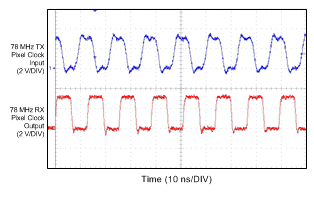SNLS422D July 2012 – August 2017 DS90UB926Q-Q1
PRODUCTION DATA.
- 1 Features
- 2 Applications
- 3 Description
- 4 Revision History
- 5 Description (continued)
- 6 Pin Configuration and Functions
-
7 Specifications
- 7.1 Absolute Maximum Ratings
- 7.2 ESD Ratings
- 7.3 Recommended Operating Conditions
- 7.4 Thermal Information
- 7.5 DC Electrical Characteristics
- 7.6 AC Electrical Characteristics
- 7.7 DC and AC Serial Control Bus Characteristics
- 7.8 Timing Requirements
- 7.9 Timing Requirements for the Serial Control Bus
- 7.10 Switching Characteristics
- 7.11 Timing Diagrams
- 7.12 Typical Characteristics
-
8 Detailed Description
- 8.1 Overview
- 8.2 Functional Block Diagram
- 8.3
Feature Description
- 8.3.1 High-Speed Forward Channel Data Transfer
- 8.3.2 Low-Speed Back Channel Data Transfer
- 8.3.3 Backward-Compatible Mode
- 8.3.4 Input Equalization Gain
- 8.3.5 Common-Mode Filter Pin (CMF)
- 8.3.6 Video Control Signal Filter
- 8.3.7 EMI Reduction Features
- 8.3.8 Enhanced Progressive Turnon (EPTO)
- 8.3.9 LVCMOS VDDIO Option
- 8.3.10 Power Down (PDB)
- 8.3.11 Stop Stream Sleep
- 8.3.12 Serial Link Fault Detect
- 8.3.13 Oscillator Output
- 8.3.14 Pixel Clock Edge Select (RFB)
- 8.3.15 Image Enhancement Features
- 8.3.16 Internal Pattern Generation
- 8.3.17 Built-In Self Test (BIST)
- 8.3.18 I2S Receiving
- 8.3.19 Interrupt Pin — Functional Description and Usage (INTB)
- 8.3.20 GPIO[3:0] and GPO_REG[8:4]
- 8.4 Device Functional Modes
- 8.5 Programming
- 8.6 Register Maps
- 9 Application and Implementation
- 10Power Supply Recommendations
- 11Layout
- 12Device and Documentation Support
- 13Mechanical, Packaging, and Orderable Information
Package Options
Mechanical Data (Package|Pins)
- NKB|60
Thermal pad, mechanical data (Package|Pins)
Orderable Information
7 Specifications
7.1 Absolute Maximum Ratings
See(1)(2)(3)(4)| MIN | MAX | UNIT | ||
|---|---|---|---|---|
| Supply voltage – VDD33 | −0.3 | 4 | V | |
| Supply voltage – VDDIO | −0.3 | 4 | V | |
| LVCMOS I/O voltage | −0.3 | (VDDIO + 0.3) | V | |
| Deserializer input voltage | −0.3 | 2.75 | V | |
| Junction temperature | 150 | °C | ||
| Maximum power dissipation capacity at 25°C | RθJA | 31 | °C/W | |
| RθJC | 2.4 | °C/W | ||
| Storage temperature, Tstg | −65 | 150 | °C | |
(1) Stresses beyond those listed under Absolute Maximum Ratings may cause permanent damage to the device. These are stress ratings only, which do not imply functional operation of the device at these or any other conditions beyond those indicated under Recommended Operating Conditions. Exposure to absolute-maximum-rated conditions for extended periods may affect device reliability.
(2) If Military/Aerospace specified devices are required, contact the Texas Instruments Sales Office/ Distributors for availability and specifications.
(3) The maximum limit (VDDIO + 0.3 V) does not apply to the PDB pin during the transition to the power down state (PDB transitioning from HIGH to LOW).
(4) For soldering specifications: see product folder at www.ti.com and Absolute Maximum Ratings for Soldering (SNOA549).
7.2 ESD Ratings
| VALUE | UNIT | ||||
|---|---|---|---|---|---|
| V(ESD) | Electrostatic discharge | Human-body model (HBM), per AEC Q100-002(1) | ±8000 | V | |
| Charged-device model (CDM), per AEC Q100-011 | ±1250 | ||||
| Machine model | ±250 | ||||
| (IEC, powered-up only) RD = 330 Ω, CS = 150 pF |
Air Discharge (Pin 49 and 50) | ±15000 | |||
| Contact Discharge (Pin 49 and 50) | ±8000 | ||||
| (ISO1060SN5), RD = 330 Ω CS = 150 pF |
Air Discharge (Pin 49 and 50) | ±15000 | |||
| Contact Discharge (Pin 49 and 50) | ±8000 | ||||
| (ISO10605), RD = 2 kΩ CS = 150 and 330 pF |
Air Discharge (Pin 49 and 50) | ±15000 | |||
| Contact Discharge (Pin 49 and 50) | ±8000 | ||||
(1) AEC Q100-002 indicates that HBM stressing shall be in accordance with the ANSI/ESDA/JEDEC JS-001 specification.
7.3 Recommended Operating Conditions
| MIN | NOM | MAX | UNIT | ||
|---|---|---|---|---|---|
| Supply voltage (VDD33) | 3 | 3.3 | 3.6 | V | |
| LVCMOS supply voltage (VDDIO) | Connect VDDIO to 3.3 V and use 3.3-V IOs | 3 | 3.3 | 3.6 | V |
| Connect VDDIO to 1.8 V and use 1.8-V IOs | 1.71 | 1.8 | 1.89 | V | |
| Operating free air temperature (TA) | −40 | 25 | 105 | °C | |
| PCLK frequency | 5 | 85 | MHz | ||
| Supply noise(1) | 100 | mVP-P | |||
(1) Supply noise testing was done with minimum capacitors on the PCB. A sinusoidal signal is AC-coupled to the VDD33 and VDDIO supplies with amplitude = 100 mVp-p measured at the device VDD33 and VDDIO pins. Bit error rate testing of input to the Ser and output of the Des with 10 meter cable shows no error when the noise frequency on the Ser is less than 50 MHz. The Des on the other hand shows no error when the noise frequency is less than 50 MHz.
7.4 Thermal Information
| THERMAL METRIC(1) | DS90UB926Q-Q1 | UNIT | |
|---|---|---|---|
| NKB (WQFN) | |||
| 60 PINS | |||
| RθJA | Junction-to-ambient thermal resistance | 26.2 | °C/W |
| RθJC(top) | Junction-to-case (top) thermal resistance | 8.1 | °C/W |
| RθJB | Junction-to-board thermal resistance | 5.2 | °C/W |
| ψJT | Junction-to-top characterization parameter | 0.1 | °C/W |
| ψJB | Junction-to-board characterization parameter | 5.2 | °C/W |
| RθJC(bot) | Junction-to-case (bottom) thermal resistance | 1.1 | °C/W |
(1) For more information about traditional and new thermal metrics, see Semiconductor and IC Package Thermal Metrics.
7.5 DC Electrical Characteristics
over recommended operating supply and temperature ranges unless otherwise specified.(1) (2) (3)| PARAMETER | TEST CONDITIONS | PIN/FREQ. | MIN | TYP | MAX | UNIT | ||
|---|---|---|---|---|---|---|---|---|
| LVCMOS I/O DC SPECIFICATIONS | ||||||||
| VIH | High Level Voltage | VDDIO = 3 to 3.6 V | PDB | 2 | VDDIO | V | ||
| VIL | Low Level Input | VDDIO = 3 to 3.6 V | GND | 0.8 | V | |||
| IIN | Input Current | VIN = 0 V or VDDIO = 3 to 3.6 V | –10 | ±1 | 10 | µA | ||
| VIH | High Level Input Voltage | VDDIO = 3 to 3.6 V | OEN, OSS_SEL, BISTEN, BISTC / INTB_IN, GPIO[3:0] | 2 | VDDIO | V | ||
| VDDIO = 1.71 to 1.89 V | 0.65 × VDDIO |
VDDIO | ||||||
| VIL | Low Level Input Voltage | VDDIO = 3 to 3.6 V | GND | 0.8 | V | |||
| VDDIO = 1.71 to 1.89 V | GND | 0.35 × VDDIO |
||||||
| IIN | Input Current | VIN = 0 V or VDDIO | VDDIO = 3 to 3.6 V |
−10 | ±1 | 10 | μA | |
| VDDIO = 1.7 to 1.89 V |
−10 | ±1 | 10 | |||||
| VOH | High Level Output Voltage | IOH = −4 mA | VDDIO = 3 to 3.6 V | ROUT[23:0], HS, VS, DE, PCLK, LOCK, PASS, MCLK, I2S_CLK, I2S_WC, I2S_DA, I2S_DB, GPO_REG[8:4] | 2.4 | VDDIO | V | |
| VDDIO = 1.7 to 1.89 V |
VDDIO – 0.45 | VDDIO | ||||||
| VOL | Low Level Output Voltage | IOL = 4 mA | VDDIO = 3 to 3.6 V | GND | 0.4 | V | ||
| VDDIO = 1.7 to 1.89 V |
GND | 0.35 | ||||||
| IOS | Output Short Circuit Current | VOUT = 0 V | −60 | mA | ||||
| IOZ | Tri-state Output Current | VOUT = 0 V or VDDIO, PDB = L | −10 | 10 | μA | |||
| FPD-LINK III CML RECEIVER INPUT DC SPECIFICATIONS | ||||||||
| VTH | Differential Threshold High Voltage | VCM = 2.5 V (Internal VBIAS) |
RIN+, RIN– | 50 | mV | |||
| VTL | Differential Threshold Low Voltage | −50 | mV | |||||
| VCM | Differential Common-mode Voltage | 1.8 | V | |||||
| RT | Internal Termination Resistor - Differential | 80 | 100 | 120 | Ω | |||
| CML MONITOR DRIVER OUTPUT DC SPECIFICATIONS | ||||||||
| VODp-p | Differential Output Voltage | RL = 100 Ω | CMLOUTP, CMLOUTN | 360 | mVp-p | |||
| SUPPLY CURRENT | ||||||||
| IDD1 | Supply Current (includes load current) f = 85 MHz |
CL = 12 pF, Checker Board Pattern (Figure 1) |
VDD33= 3.6 V | VDD33 | 125 | 145 | mA | |
| IDDIO1 | VDDIO= 3.6 V | VDDIO | 110 | 118 | mA | |||
| VDDIO = 1.89 V | 60 | 75 | ||||||
| IDD2 | Supply Current (includes load current) f = 85MHz |
CL = 4 pF Checker Board Pattern (Figure 1) |
VDD33 = 3.6 V | VDD33 | 125 | 145 | mA | |
| IDDIO2 | VDDIO = 3.6 V | VDDIO | 75 | 85 | mA | |||
| VDDIO = 1.89 V | 50 | 65 | ||||||
| IDDS | Supply Current Sleep Mode | Without Input Serial Stream | VDD33 = 3.6 V | VDD33 | 90 | 115 | mA | |
| IDDIOS | VDDIO = 3.6 V | VDDIO | 3 | 5 | mA | |||
| VDDIO = 1.89 V | 2 | 3 | ||||||
| IDDZ | Supply Current Power Down | PDB = L, All LVCMOS inputs are floating or tied to GND | VDD33 = 3.6 V | VDD33 | 2 | 10 | mA | |
| IDDIOZ | VDDIO = 3.6 V | VDDIO | 0.05 | 10 | mA | |||
| VDDIO = 1.89 V | 0.05 | 10 | ||||||
(1) The Electrical Characteristics tables list ensured specifications under the listed Recommended Operating Conditions except as otherwise modified or specified by the Electrical Characteristics Conditions and/or Notes. Typical specifications are estimations only and are not ensured.
(2) Typical values represent most likely parametric norms at VDD = 3.3 V, TA = 25°C, and at the Recommended Operating Conditions at the time of product characterization and are not ensured.
(3) Current into device pins is defined as positive. Current out of a device pin is defined as negative. Voltages are referenced to ground except VOD and ΔVOD, which are differential voltages.
7.6 AC Electrical Characteristics
Over recommended operating supply and temperature ranges unless otherwise specified.(1) (2) (3)| PARAMETER | TEST CONDITIONS | PIN/FREQ. | MIN | TYP | MAX | UNIT | |
|---|---|---|---|---|---|---|---|
| GPIO BIT RATE | |||||||
| BR | Forward Channel Bit Rate | See(5)(6) | f = 5 to 85 MHz, GPIO[3:0] |
0.25 × f | Mbps | ||
| Back Channel Bit Rate | >50 | >75 | kbps | ||||
| CML MONITOR DRIVER OUTPUT AC SPECIFICATIONS | |||||||
| EW | Differential Output Eye Opening Width(4) | RL = 100 Ω, Jitter Freq > f / 40 (Figure 2)(5)(6) |
CMLOUTP, CMLOUTN, f = 85 MHz |
0.3 | 0.4 | UI | |
| EH | Differential Output Eye Height | 200 | 300 | mV | |||
| BIST MODE | |||||||
| tPASS | BIST PASS Valid Time BISTEN = H (Figure 8)(5)(6) |
PASS | 800 | ns | |||
| SSCG MODE | |||||||
| fDEV | Spread Spectrum Clocking Deviation Frequency | See Figure 14, Table 1, Table 2 (5) (6) | f = 85 MHz, SSCG = ON |
±0.5% | ±2.5% | ||
| fMOD | Spread Spectrum Clocking Modulation Frequency | 8 | 100 | kHz | |||
(1) The Electrical Characteristics tables list ensured specifications under the listed in Recommended Operating Conditions except as otherwise modified or specified by the Electrical Characteristics Conditions and/or Notes. Typical specifications are estimations only and are not ensured.
(2) Typical values represent most likely parametric norms at VDD = 3.3 V, TA = 25 °C, and at the Recommended Operating Conditions at the time of product characterization and are not ensured.
(3) Current into device pins is defined as positive. Current out of a device pin is defined as negative. Voltages are referenced to ground except VOD and ΔVOD, which are differential voltages.
(4) UI – Unit Interval is equivalent to one serialized data bit width (1UI = 1 / 35 * PCLK). The UI scales with PCLK frequency.
(5) Specification is ensured by characterization and is not tested in production.
(6) Specification is ensured by design and is not tested in production.
7.7 DC and AC Serial Control Bus Characteristics
Over 3.3-V supply and temperature ranges unless otherwise specified.(1) (2) (3)| PARAMETER | TEST CONDITIONS | MIN | TYP | MAX | UNIT | |
|---|---|---|---|---|---|---|
| VIH | Input High Level | SDA and SCL | 0.7 × VDD33 |
VDD33 | V | |
| VIL | Input Low Level Voltage | SDA and SCL | GND | 0.3 × VDD33 |
V | |
| VHY | Input Hysteresis | > 50 | mV | |||
| VOL | SDA, IOL = 1.25 mA | 0 | 0.36 | V | ||
| Iin | SDA or SCL, VIN = VDD33 or GND | –10 | 10 | µA | ||
| tR | SDA RiseTime – READ | SDA, RPU = 10 kΩ, Cb ≤ 400 pF (Figure 9) | 430 | ns | ||
| tF | SDA Fall Time – READ | 20 | ns | |||
| tSU;DAT | Setup Time — READ | See Figure 9 | 560 | ns | ||
| tHD;DAT | Holdup Time — READ | See Figure 9 | 615 | ns | ||
| tSP | Input Filter | 50 | ns | |||
| Cin | Input Capacitance | SDA or SCL | < 5 | pF | ||
(1) The Electrical Characteristics tables list ensured specifications under the listed Recommended Operating Conditions except as otherwise modified or specified by the Electrical Characteristics Conditions and/or Notes. Typical specifications are estimations only and are not ensured.
(2) Typical values represent most likely parametric norms at VDD = 3.3 V, TA = 25°C, and at the Recommended Operating Conditions at the time of product characterization and are not ensured.
(3) Current into device pins is defined as positive. Current out of a device pin is defined as negative. Voltages are referenced to ground except VOD and ΔVOD, which are differential voltages.
7.8 Timing Requirements
| MIN | NOM | MAX | UNIT | |||
|---|---|---|---|---|---|---|
| tR | SDA RiseTime – READ | SDA, RPU = 10 kΩ, Cb ≤ 400 pF (Figure 9) | 430 | ns | ||
| tF | SDA Fall Time – READ | 20 | ns | |||
| tSU;DAT | Setup Time — READ | See Figure 9 | 560 | ns | ||
| tHD;DAT | Holdup Time — READ | See Figure 9 | 615 | ns | ||
| tSP | Input Filter | 50 | ns | |||
7.9 Timing Requirements for the Serial Control Bus
Over 3.3-V supply and temperature ranges unless otherwise specified.| MIN | NOM | MAX | UNIT | |||
|---|---|---|---|---|---|---|
| fSCL | SCL Clock Frequency | Standard Mode | 0 | 100 | kHz | |
| Fast Mode | 0 | 400 | kHz | |||
| tLOW | SCL Low Period | Standard Mode | 4.7 | µs | ||
| Fast Mode | 1.3 | µs | ||||
| tHIGH | SCL High Period | Standard Mode | 4 | µs | ||
| Fast Mode | 0.6 | µs | ||||
| tHD;STA | Hold time for a start or a repeated start condition (Figure 9) | Standard Mode | 4 | µs | ||
| Fast Mode | 0.6 | µs | ||||
| tSU:STA | Setup time for a start or a repeated start condition (Figure 9) | Standard Mode | 4.7 | µs | ||
| Fast Mode | 0.6 | µs | ||||
| tHD;DAT | Data Hold Time (Figure 9) | Standard Mode | 0 | 3.45 | µs | |
| Fast Mode | 0 | 0.9 | µs | |||
| tSU;DAT | Data Setup Time (Figure 9) | Standard Mode | 250 | ns | ||
| Fast Mode | 100 | ns | ||||
| tSU;STO | Setup Time for STOP Condition (Figure 9) | Standard Mode | 4 | µs | ||
| Fast Mode | 0.6 | µs | ||||
| tBUF | Bus Free Time between STOP and START (Figure 9) | Standard Mode | 4.7 | µs | ||
| Fast Mode | 1.3 | µs | ||||
| tr | SCL and SDA Rise Time (Figure 9) | Standard Mode | 1000 | ns | ||
| Fast Mode | 300 | ns | ||||
| tf | SCL and SDA Fall Time (Figure 9) | Standard Mode | 300 | ns | ||
| Fast mode | 300 | ns |
7.10 Switching Characteristics
over operating free-air temperature range (unless otherwise noted)| PARAMETER | TEST CONDITIONS | PIN/FREQ. | MIN | TYP | MAX | UNIT | |
|---|---|---|---|---|---|---|---|
| tRCP | PCLK Output Period | tRCP = tTCP | PCLK | 11.76 | T | 200 | ns |
| tRDC | PCLK Output Duty Cycle | 45% | 50% | 55% | |||
| tCLH | LVCMOS Low-to-High Transition Time (Figure 3) | VDDIO = 1.71 to 1.89 V, CL = 12 pF |
ROUT[23:0], HS, VS, DE, PCLK, LOCK, PASS, MCLK, I2S_CLK, I2S_WC, I2S_DA, I2S_DB | 2 | 3 | ns | |
| VDDIO = 3 to 3.6 V, CL = 12 pF |
2 | 3 | ns | ||||
| tCHL | LVCMOS High-to-Low Transition Time (Figure 3) | VDDIO = 1.71 to 1.89 V, CL = 12 pF |
2 | 3 | ns | ||
| VDDIO = 3 to 3.6 V, CL = 12 pF |
2 | 3 | ns | ||||
| tROS | Data Valid before PCLK – Setup Time SSCG = OFF (Figure 6) |
VDDIO = 1.71 to 1.89 V, CL = 12 pF |
2.2 | ns | |||
| VDDIO = 3 to 3.6 V, CL = 12 pF |
2.2 | ns | |||||
| tROH | Data Valid after PCLK – Hold Time SSCG = OFF (Figure 6) |
VDDIO = 1.71 to 1.89 V, CL = 12 pF |
3 | ns | |||
| VDDIO = 3 to 3.6 V, CL = 12 pF |
3 | ns | |||||
| tXZR | Active to OFF Delay (Figure 5)(1) (2) | OEN = L, OSS_SEL = H | ROUT[23:0] | 10 | ns | ||
| HS, VS, DE, PCLK, LOCK, PASS | 15 | ns | |||||
| MCLK, I2S_CLK, I2S_WC, I2S_DA, I2S_DB | 60 | ns | |||||
| tDDLT | Lock Time (Figure 5)(1)(2)(3) | SSCG = OFF | f = 5 to 85MHz | 5 | 40 | ns | |
| tDD | Delay – Latency(1)(2) | f = 5 to 85MHz | 147*T | ns | |||
| tDCCJ | Cycle-to-Cycle Jitter(1)(2) | SSCG = OFF | f = 5 to <15 MHz | 0.5 | ns | ||
| f = 15 to 85 MHz | 0.2 | ns | |||||
| I2S_CLK = 1 to 12.28MHz | ±2 | ns | |||||
| tONS | Data Valid After OEN = H SetupTime (Figure 7)(1)(2) | VDDIO = 1.71 to 1.89 V, CL = 12 pF |
ROUT[23:0], HS, VS, DE, PCLK, MCLK, I2S_CLK, I2S_WC, I2S_DA, I2S_DB | 50 | ns | ||
| VDDIO = 3 to 3.6 V, CL = 12 pF |
50 | ns | |||||
| tONH | Data Tri-State After OEN = L SetupTime (Figure 7)(1)(2) | VDDIO = 1.71 to 1.89 V, CL = 12 pF |
50 | ns | |||
| VDDIO = 3 to 3.6 V, CL = 12 pF |
50 | ns | |||||
| tSES | Data Tri-State after OSS_ SEL = H, Setup Time (Figure 7)(1)(2) | VDDIO = 1.71 to 1.89 V, CL = 12 pF |
5 | ns | |||
| VDDIO = 3 to 3.6 V, CL = 12 pF |
5 | ns | |||||
| tSEH | Data to Low after OSS_SEL = L Setup Time (Figure 7)(1)(2) | VDDIO = 1.71 to 1.89 V, CL = 12 pF |
5 | ns | |||
| VDDIO = 3 to 3.6 V, CL = 12 pF |
5 | ns | |||||
(1) Specification is ensured by characterization and is not tested in production.
(2) Specification is ensured by design and is not tested in production.
(3) tDDLT is the time required by the device to obtain lock when exiting power-down state with an active serial stream.
7.11 Timing Diagrams
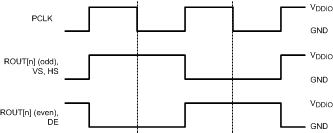 Figure 1. Checker Board Data Pattern
Figure 1. Checker Board Data Pattern
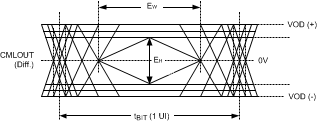 Figure 2. CML Output Driver
Figure 2. CML Output Driver
 Figure 3. LVCMOS Transition Times
Figure 3. LVCMOS Transition Times
 Figure 4. Delay - Latency
Figure 4. Delay - Latency
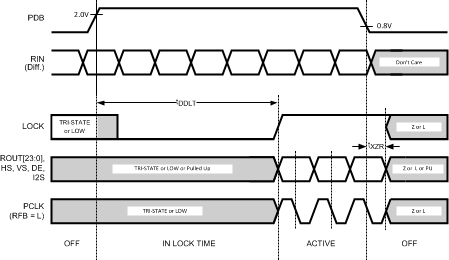 Figure 5. PLL Lock Times and PDB Tri-State Delay
Figure 5. PLL Lock Times and PDB Tri-State Delay
 Figure 6. Output Data Valid (Setup and Hold) Times With SSCG = Off
Figure 6. Output Data Valid (Setup and Hold) Times With SSCG = Off
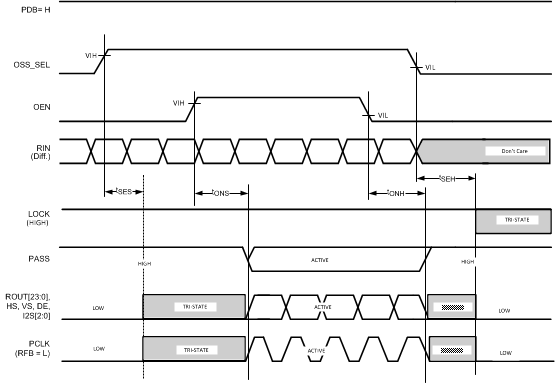 Figure 7. Output State (Setup and Hold) Times
Figure 7. Output State (Setup and Hold) Times
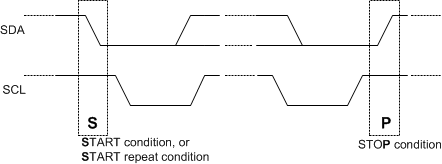 Figure 8. BIST PASS Waveform
Figure 8. BIST PASS Waveform
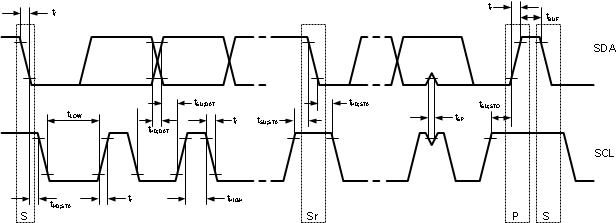 Figure 9. Serial Control Bus Timing Diagram
Figure 9. Serial Control Bus Timing Diagram
7.12 Typical Characteristics
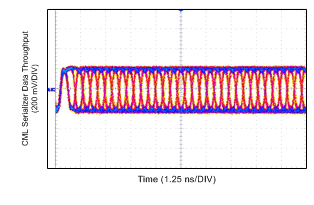
| Note: On the rising edge of each clock period, the CML driver outputs a low Stop bit, high Start bit, and 33 DC-scrambled data bits. | ||
With 78-MHZ TX Pixel Clock
